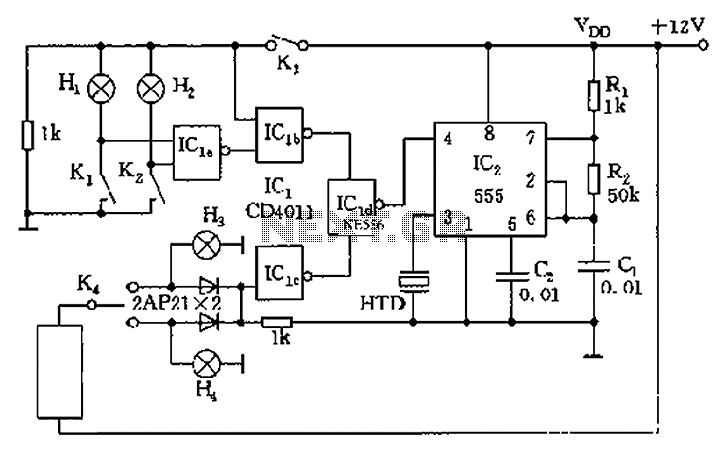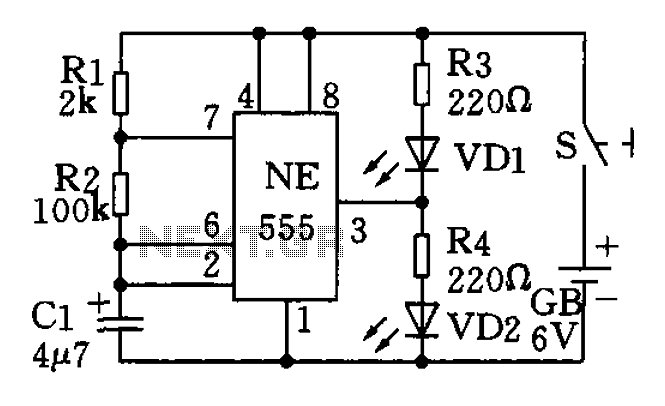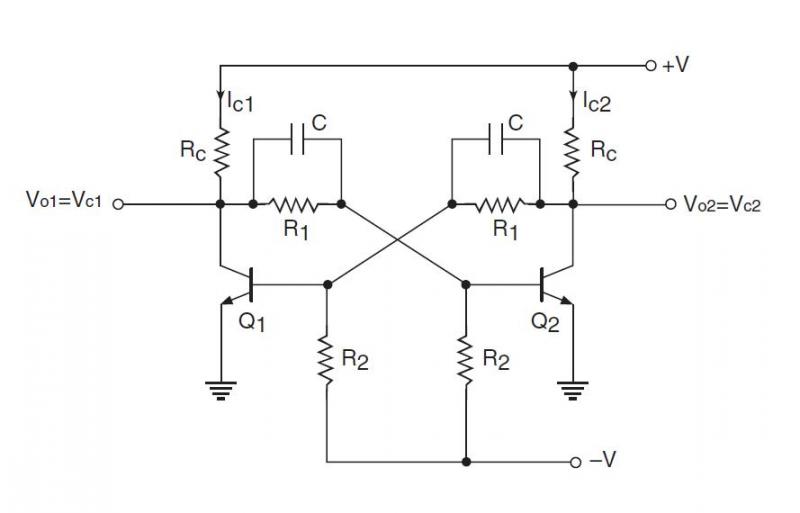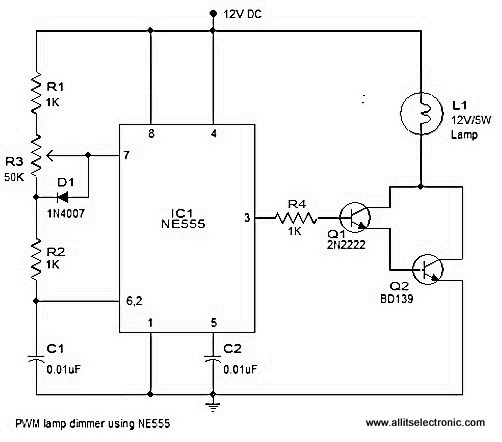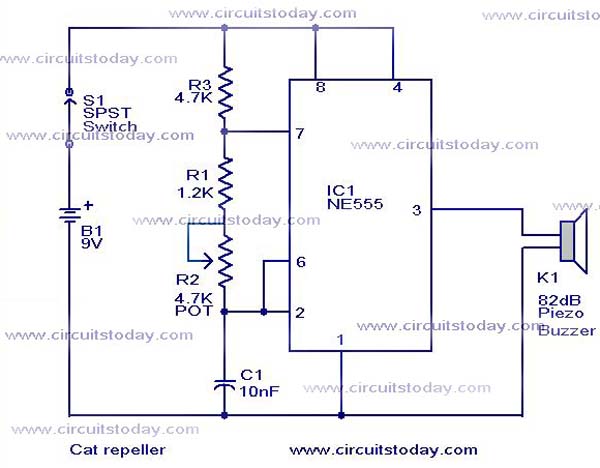
555 Timer as Monostable Multivibrator
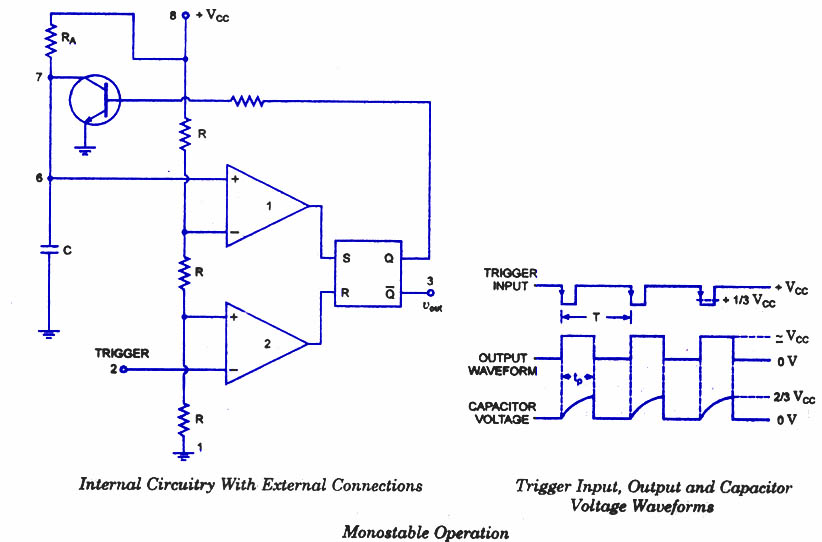
Are you familiar with the basics and applications of the 555 timer IC? Are you looking for a book that provides all these basics? If so, CircuitsToday has started an online store where you can purchase books on the 555 timer IC, which have been reviewed in detail. You can go through the reviews and buy them here: 3 Great Books to Learn 555 Timer Circuits and Projects. A monostable multivibrator (MMV), often called a one-shot multivibrator, is a pulse generator circuit in which the duration of the pulse is determined by the R-C network connected externally to the 555 timer. In this configuration, one output state is stable while the other is quasi-stable (unstable). For auto-triggering of the output from the quasi-stable state to the stable state, energy is stored by an externally connected capacitor (C) to a reference level. The time taken for storage determines the pulse width. The transition of the output from the stable state to the quasi-stable state is accomplished by external triggering. The schematic of a 555 timer in monostable mode of operation is shown in the figure. Pin 1 is grounded. Trigger input is applied to pin 2. In the quiescent condition of output, this input is kept at +VCC. To obtain the transition of output from the stable state to the quasi-stable state, a negative-going pulse of narrow width (smaller than the expected pulse width of the output waveform) and amplitude greater than +2/3 VCC is applied to pin 2. The output is taken from pin 3. Pin 4 is usually connected to +VCC to avoid accidental reset. Pin 5 is grounded through a 0.01 µF capacitor to avoid noise issues. Pin 6 (threshold) is shorted to pin 7. A resistor (RA) is connected between pins 6 and 8. At pin 7, a discharge capacitor is connected while pin 8 is connected to supply VCC. Initially, when the output at pin 3 is low, meaning the circuit is in a stable state, the transistor is on and capacitor C is shorted to ground. When a negative pulse is applied to pin 2, the trigger input falls below +1/3 VCC, causing the output of the comparator to go high, which resets the flip-flop. Consequently, the transistor turns off and the output at pin 3 goes high. This marks the transition of the output from stable to quasi-stable state, as shown in the figure. As the discharge transistor is cut off, capacitor C begins charging toward +VCC through resistance RA with a time constant equal to RAC. When the increasing capacitor voltage becomes slightly greater than +2/3 VCC, the output of comparator 1 goes high, which sets the flip-flop. The transistor goes into saturation, thereby discharging capacitor C and causing the output of the timer to go low, as illustrated in the figure. The output of the Monostable Multivibrator remains low until a trigger pulse is applied again, after which the cycle repeats. Trigger input, output voltage, and capacitor voltage waveforms are shown in the figure, where RA is in ohms and C is in farads. The pulse width of the circuit may range from microseconds to many seconds, making this circuit widely used in industry for various timing applications.
The 555 timer IC, particularly in its monostable mode, serves a critical function in various electronic applications, including timers, pulse generation, and frequency division. The monostable multivibrator configuration allows for the generation of a single output pulse in response to an input trigger. The pulse width, which can be adjusted by varying the resistor (RA) and capacitor (C) values, provides flexibility in timing applications.
In practical implementations, the 555 timer is often used in conjunction with other components to create sophisticated timing circuits. For instance, it can be paired with additional resistors and capacitors to create a delay timer that can control the operation of other devices, such as motors or LED indicators. Additionally, the output signal can be interfaced with other logic circuits, enabling the 555 timer to function as part of larger systems, such as alarms, sensors, and control systems.
The reliability and ease of use of the 555 timer make it a staple in both educational settings and professional engineering applications. Its ability to produce precise timing intervals and its robustness under various operating conditions contribute to its widespread adoption in electronic design. Understanding the principles and applications of the 555 timer IC is essential for anyone involved in electronics, whether for hobbyist projects or industrial applications.Are you familiar with the basics and applications of the 555 timer IC Are you looking for a book that provides all these basics If so, CircuitsToday has started an online store from where you can buy books on 555 timer IC, which have been reviewed in detail. You can go through the reviews and buy them here:- 3 Great Books to Learn 555 Timer Circ uits and Projects A monostable multivibrator (MMV) often called a one-shot multivibrator, is a pulse generator circuit in which the duration of the pulse is determined by the R-C network, connected externally to the 555 timer. In such a vibrator, one state of output is stable while the other is quasi-stable (unstable). For auto-triggering of output from quasi-stable state to stable state energy is stored by an externally connected capaci tor C to a reference level.
The time taken in storage determines the pulse width. The transition of output from stable state to quasi-stable state is accom plished by external triggering. The schematic of a 555 timer in monostable mode of operation is shown in figure. Pin 1 is grounded. Trigger input is applied to pin 2. In quiescent condition of output this input is kept at + VCC. To obtain transition of output from stable state to quasi-stable state, a negative-going pulse of narrow width (a width smaller than expected pulse width of output waveform) and amplitude of greater than + 2/3 VCC is applied to pin 2.
Output is taken from pin 3. Pin 4 is usually connected to + VCC to avoid accidental reset. Pin 5 is grounded through a 0. 01 u F capacitor to avoid noise problem. Pin 6 (threshold) is shorted to pin 7. A resistor RA is connected between pins 6 and 8. At pins 7 a discharge capacitor is connected while pin 8 is connected to supply VCC. Initially, when the output at pin 3 is low i. e. the circuit is in a stable state, the transistor is on and capacitor- C is shortedto ground. When a negative pulse is applied to pin 2, the trigger input falls below +1/3 VCC, the output of comparator goes high which resets the flip-flop and consequently the transistor turns off and the output at pin 3 goes high. This is the transition of the output from stable to quasi-stable state, as shown in figure. As the discharge transistor is cut off, the capacitor C begins charging toward +VCC through resistance RA with a time constant equal to RAC.
When the increasing capacitor voltage becomes slightly greater than +2/3 VCC, the output of comparator 1 goes high, which sets the flip-flop. The transistor goes to saturation, thereby discharging the capacitor C and the output of the timer goes low, as illustrated in figure.
The output of the Monostable Multivibrator remains low until a trigger pulse is again applied. Then the cycle repeats. Trigger input, output voltage and capacitor voltage waveforms are shown in figure. where RA is in ohms and C is in farads. The above relation is derived as below. Voltage across the capacitor at any instant during charging period is given as The pulse width of the circuit may range from micro-seconds to many seconds. This circuit is widely used in industry for many different timing applications. 🔗 External reference
The 555 timer IC, particularly in its monostable mode, serves a critical function in various electronic applications, including timers, pulse generation, and frequency division. The monostable multivibrator configuration allows for the generation of a single output pulse in response to an input trigger. The pulse width, which can be adjusted by varying the resistor (RA) and capacitor (C) values, provides flexibility in timing applications.
In practical implementations, the 555 timer is often used in conjunction with other components to create sophisticated timing circuits. For instance, it can be paired with additional resistors and capacitors to create a delay timer that can control the operation of other devices, such as motors or LED indicators. Additionally, the output signal can be interfaced with other logic circuits, enabling the 555 timer to function as part of larger systems, such as alarms, sensors, and control systems.
The reliability and ease of use of the 555 timer make it a staple in both educational settings and professional engineering applications. Its ability to produce precise timing intervals and its robustness under various operating conditions contribute to its widespread adoption in electronic design. Understanding the principles and applications of the 555 timer IC is essential for anyone involved in electronics, whether for hobbyist projects or industrial applications.Are you familiar with the basics and applications of the 555 timer IC Are you looking for a book that provides all these basics If so, CircuitsToday has started an online store from where you can buy books on 555 timer IC, which have been reviewed in detail. You can go through the reviews and buy them here:- 3 Great Books to Learn 555 Timer Circ uits and Projects A monostable multivibrator (MMV) often called a one-shot multivibrator, is a pulse generator circuit in which the duration of the pulse is determined by the R-C network, connected externally to the 555 timer. In such a vibrator, one state of output is stable while the other is quasi-stable (unstable). For auto-triggering of output from quasi-stable state to stable state energy is stored by an externally connected capaci tor C to a reference level.
The time taken in storage determines the pulse width. The transition of output from stable state to quasi-stable state is accom plished by external triggering. The schematic of a 555 timer in monostable mode of operation is shown in figure. Pin 1 is grounded. Trigger input is applied to pin 2. In quiescent condition of output this input is kept at + VCC. To obtain transition of output from stable state to quasi-stable state, a negative-going pulse of narrow width (a width smaller than expected pulse width of output waveform) and amplitude of greater than + 2/3 VCC is applied to pin 2.
Output is taken from pin 3. Pin 4 is usually connected to + VCC to avoid accidental reset. Pin 5 is grounded through a 0. 01 u F capacitor to avoid noise problem. Pin 6 (threshold) is shorted to pin 7. A resistor RA is connected between pins 6 and 8. At pins 7 a discharge capacitor is connected while pin 8 is connected to supply VCC. Initially, when the output at pin 3 is low i. e. the circuit is in a stable state, the transistor is on and capacitor- C is shortedto ground. When a negative pulse is applied to pin 2, the trigger input falls below +1/3 VCC, the output of comparator goes high which resets the flip-flop and consequently the transistor turns off and the output at pin 3 goes high. This is the transition of the output from stable to quasi-stable state, as shown in figure. As the discharge transistor is cut off, the capacitor C begins charging toward +VCC through resistance RA with a time constant equal to RAC.
When the increasing capacitor voltage becomes slightly greater than +2/3 VCC, the output of comparator 1 goes high, which sets the flip-flop. The transistor goes to saturation, thereby discharging the capacitor C and the output of the timer goes low, as illustrated in figure.
The output of the Monostable Multivibrator remains low until a trigger pulse is again applied. Then the cycle repeats. Trigger input, output voltage and capacitor voltage waveforms are shown in figure. where RA is in ohms and C is in farads. The above relation is derived as below. Voltage across the capacitor at any instant during charging period is given as The pulse width of the circuit may range from micro-seconds to many seconds. This circuit is widely used in industry for many different timing applications. 🔗 External reference
